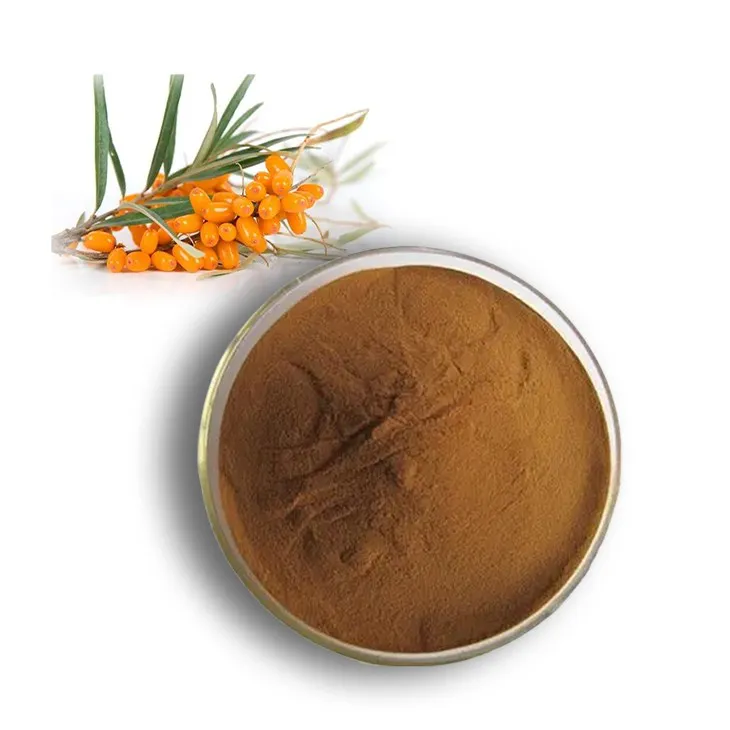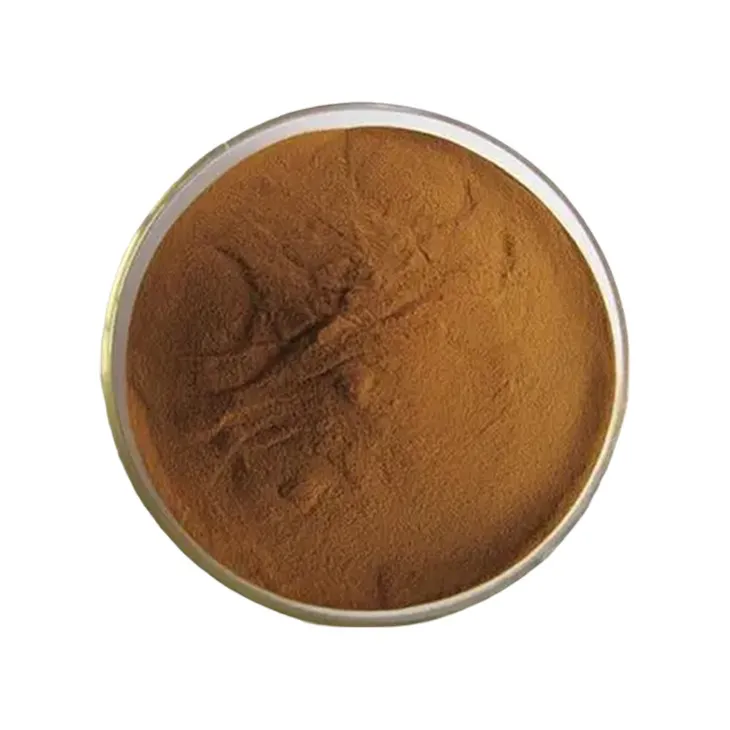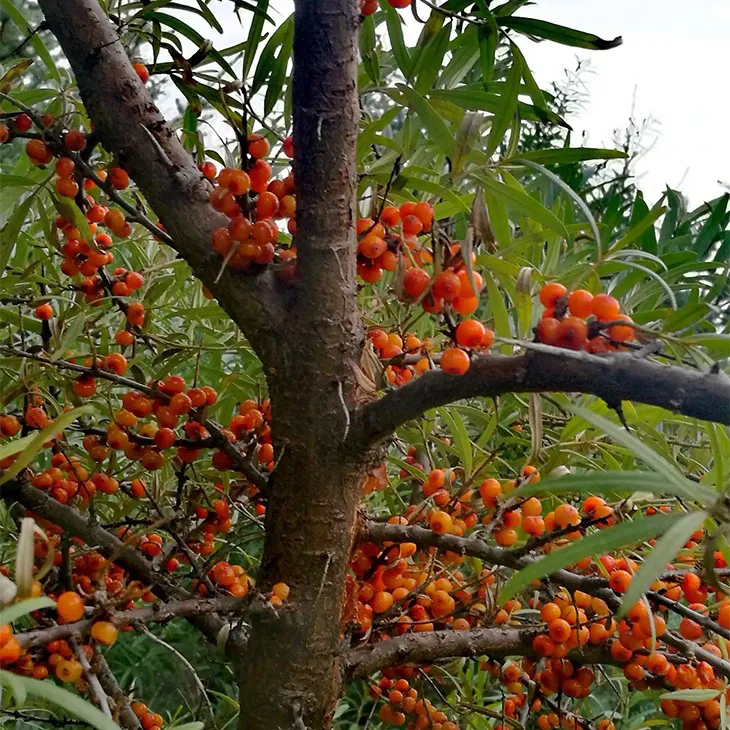- 0086-571-85302990
- sales@greenskybio.com
How to extract seabuckthorn bark extract from plants?
2024-11-30

1. Introduction
Seabuckthorn (Hippophae rhamnoides) is a remarkable plant known for its numerous health - promoting properties. The bark of seabuckthorn contains a variety of bioactive compounds, making its extract highly valuable in fields such as medicine, cosmetics, and food supplements. Understanding the process of extracting seaBuckthorn bark extract from plants is crucial for harnessing its potential benefits.

2. Significance of SeaBuckthorn bark extract
2.1. In Medicine
- SeaBuckthorn bark extract has been found to possess antioxidant properties. It can help in combating oxidative stress in the body, which is associated with various diseases such as cancer, heart diseases, and neurodegenerative disorders.
- It also has anti - inflammatory effects. This makes it useful in treating inflammatory conditions like arthritis, where it can reduce pain and swelling.
- The extract is rich in vitamins, minerals, and fatty acids. These components can nourish the skin, improve skin elasticity, and prevent premature aging. For example, the presence of vitamin E in the extract helps in protecting the skin from damage caused by free radicals.
- It can also be used in hair care products. Seabuckthorn bark extract can strengthen hair follicles, reduce hair loss, and add shine to the hair.

3. Initial Plant Selection
3.1. Species Consideration
- There are different species of seabuckthorn, and the choice of species can affect the quality and quantity of the bark extract. Hippophae rhamnoides is the most commonly used species for extraction. However, within this species, there may be different subspecies or varieties that need to be carefully selected depending on the intended use of the extract.
- Some subspecies may be more suitable for medicinal applications due to higher concentrations of certain bioactive compounds, while others may be better for cosmetic applications because of their unique fatty acid profiles.
- Seabuckthorn plants growing in different habitats can have variations in their bark composition. Plants growing in unpolluted, natural habitats are generally preferred as they are less likely to contain contaminants. For example, seabuckthorn plants growing in mountainous regions with clean air and water sources are often considered ideal.
- It is also important to consider the origin of the plants. Plants sourced from areas with a long history of seabuckthorn cultivation may have been bred for certain desirable traits, which can be beneficial for extraction.

4. Proper Harvesting Techniques
4.1. Timing of Harvest
- The timing of harvesting seabuckthorn bark is crucial. It is generally recommended to harvest the bark during the dormant season of the plant, which is usually in late autumn or winter. During this time, the plant's metabolism is slow, and the concentration of bioactive compounds in the bark may be relatively stable.
- Harvesting too early or too late can affect the quality of the extract. For example, if harvested too early, the bark may not have fully developed its bioactive compounds, and if harvested too late, there may be a decrease in the concentration of certain compounds due to natural degradation processes.
- When harvesting seabuckthorn bark, it is important to use proper tools. A sharp knife or pruning shears can be used to carefully remove the bark without causing excessive damage to the underlying cambium layer. Excessive damage to the cambium can harm the plant's growth and future productivity.
- Only a portion of the bark should be harvested from each plant. A general guideline is to harvest no more than one - third of the circumference of the trunk or branch at a time. This allows the plant to recover and continue to grow healthily.

5. Extraction Methods
5.1. Solvent Extraction
-
5.1.1. Choice of Solvent
- Organic solvents such as ethanol, methanol, and ethyl acetate are commonly used for seabuckthorn bark extraction. Ethanol is a popular choice as it is relatively safe, can dissolve a wide range of bioactive compounds, and is also acceptable for use in products intended for human consumption in appropriate concentrations.
- The choice of solvent depends on the nature of the bioactive compounds to be extracted. For example, if the target compounds are more polar, a polar solvent like ethanol may be more effective, while for less polar compounds, a less polar solvent such as ethyl acetate may be preferred.
-
5.1.2. Extraction Process
- The seabuckthorn bark is first dried and ground into a fine powder. This increases the surface area available for extraction. The powdered bark is then mixed with the chosen solvent in a suitable container, usually in a ratio of bark to solvent such as 1:5 or 1:10, depending on the extraction requirements.
- The mixture is then stirred or shaken for a certain period, usually several hours to days. This allows the solvent to penetrate the bark particles and dissolve the bioactive compounds. After that, the mixture is filtered to separate the liquid extract from the solid residue.
- The solvent can be removed from the extract using techniques such as evaporation under reduced pressure. This leaves behind the seabuckthorn bark extract in a more concentrated form.
-
5.2.1. Principles of Supercritical Fluid Extraction
- Supercritical fluid extraction (SFE) uses a supercritical fluid, most commonly carbon dioxide (CO₂), as the extraction medium. A supercritical fluid has properties between those of a liquid and a gas. It has a high diffusivity like a gas, which allows it to penetrate the seabuckthorn bark quickly, and a density similar to that of a liquid, enabling it to dissolve a wide range of bioactive compounds effectively.
- The critical temperature and pressure of CO₂ are relatively low (critical temperature: 31.1 °C, critical pressure: 73.8 bar), which makes it a suitable and relatively safe supercritical fluid for extraction. By adjusting the temperature and pressure around the critical point, the solubility of different bioactive compounds in CO₂ can be controlled.
-
5.2.2. SFE Extraction Process
- The seabuckthorn bark is first prepared by drying and grinding it into a suitable particle size. The ground bark is then placed in the extraction chamber of the SFE equipment. The CO₂ is pressurized and heated to reach its supercritical state and is then passed through the bark in the extraction chamber.
- The supercritical CO₂ extracts the bioactive compounds from the bark. The extract - laden CO₂ is then passed through a separator where the pressure and/or temperature are adjusted to cause the CO₂ to return to its gaseous state, leaving behind the seabuckthorn bark extract.
- Supercritical fluid extraction has several advantages over solvent extraction. It is a more environmentally friendly process as CO₂ is non - toxic and can be easily recycled. It also produces a purer extract as there is no residue from organic solvents in the final product.
6. Quality Control of Seabuckthorn Bark Extract
6.1. Analysis of Bioactive Compounds
- Once the seabuckthorn bark extract is obtained, it is important to analyze the content of bioactive compounds. Techniques such as high - performance liquid chromatography (HPLC) and gas chromatography - mass spectrometry (GC - MS) can be used to identify and quantify the presence of compounds such as flavonoids, phenolic acids, and fatty acids.
- The analysis helps in ensuring that the extract meets the required quality standards for its intended application. For example, in the case of a medicinal extract, the concentration of certain active ingredients must be within a specified range for it to be effective.
- Testing for purity is essential. The extract should be free from contaminants such as heavy metals, pesticides, and microbial contaminants. Methods such as atomic absorption spectroscopy can be used to detect heavy metals, and microbiological assays can be employed to check for the presence of bacteria, fungi, and other microorganisms.
- If the extract is intended for use in cosmetics or food supplements, strict limits on contaminants are set by regulatory authorities. Ensuring the purity of the seabuckthorn bark extract is crucial for consumer safety and product efficacy.
7. Conclusion
Extracting seabuckthorn bark extract from plants is a multi - step process that requires careful consideration at each stage. From the initial plant selection to proper harvesting techniques and choice of extraction method, every step plays a vital role in obtaining a high - quality extract. With the increasing demand for natural products in medicine, cosmetics, and other industries, understanding and optimizing the extraction process of seabuckthorn bark extract will continue to be of great importance. By ensuring the quality of the extract through proper extraction and quality control methods, we can fully utilize the potential of seabuckthorn bark extract in various applications.
FAQ:
Q1: What are the key factors to consider when selecting seabuckthorn plants for bark extract?
When selecting seabuckthorn plants for bark extract, several factors are crucial. Firstly, the age of the plant matters. Generally, mature plants are preferred as they tend to have more developed bark with potentially higher concentrations of the desired compounds. Secondly, the health of the plant is important. Healthy plants are more likely to produce high - quality bark. Also, the origin or variety of the seabuckthorn can influence the composition of the bark extract. Different varieties may have varying levels of active ingredients, so choosing the appropriate variety for the intended application is necessary.
Q2: What are the proper harvesting techniques for seabuckthorn bark?
Harvesting seabuckthorn bark should be done carefully. It is important to avoid causing excessive damage to the plant. One common method is to use sharp tools to carefully strip a thin layer of bark, preferably during the appropriate season. In some cases, it may be necessary to ensure that the plant has enough time to recover after harvesting. For example, not harvesting too much bark from a single plant at once. Also, following any local regulations or ethical guidelines regarding the harvesting of seabuckthorn bark is essential.
Q3: How does solvent extraction work for seabuckthorn bark extract?
Solvent extraction involves using a suitable solvent to dissolve the desired compounds from the seabuckthorn bark. First, the seabuckthorn bark is usually ground into a fine powder to increase the surface area. Then, the solvent, such as ethanol or methanol, is added to the powdered bark. The mixture is stirred or agitated for a period of time to allow the solvent to penetrate the bark and dissolve the target compounds. After that, the mixture is filtered to separate the liquid extract (containing the dissolved compounds) from the solid residue. The solvent is then typically removed, for example, through evaporation, leaving behind the seabuckthorn bark extract.
Q4: What are the advantages of supercritical fluid extraction for seabuckthorn bark extract?
Supercritical fluid extraction has several advantages. One major advantage is that it can operate at relatively low temperatures, which helps to preserve the thermally sensitive compounds in the seabuckthorn bark. This can result in a higher - quality extract. Also, supercritical fluids, such as carbon dioxide, have properties that allow for selective extraction, meaning that they can target specific compounds more effectively compared to some traditional solvents. Additionally, the extraction process using supercritical fluids is often more environmentally friendly as it can reduce the use of toxic solvents and produce less waste.
Q5: What are the main applications of seabuckthorn bark extract in medicine?
Seabuckthorn bark extract has various applications in medicine. It may have antioxidant properties, which can help in protecting cells from oxidative damage. It could also potentially have anti - inflammatory effects, making it useful in treating certain inflammatory conditions. Some studies suggest that it may play a role in promoting wound healing, perhaps due to its ability to stimulate cell growth and tissue repair. Additionally, it may have antimicrobial properties, which could be beneficial in fighting against certain infections.
Q6: How can the quality of seabuckthorn bark extract be ensured?
To ensure the quality of seabuckthorn bark extract, multiple steps are involved. Starting from the proper selection and harvesting of the plants as mentioned before. During the extraction process, using high - quality solvents (if applicable) and maintaining proper extraction conditions, such as temperature, pressure (in the case of supercritical fluid extraction), and extraction time, is crucial. After extraction, proper storage conditions should be maintained to prevent degradation of the extract. Quality control tests, such as analysis of the active ingredient content, purity, and absence of contaminants, should also be carried out regularly.
Related literature
- Extraction and Characterization of Bioactive Compounds from Seabuckthorn Bark"
- "Seabuckthorn Bark: A Potential Source of Valuable Phytochemicals - Extraction and Applications"
- "Advances in Seabuckthorn Bark Extract Production and Its Therapeutic Potential"
- ▶ Hesperidin
- ▶ Citrus Bioflavonoids
- ▶ Plant Extract
- ▶ lycopene
- ▶ Diosmin
- ▶ Grape seed extract
- ▶ Sea buckthorn Juice Powder
- ▶ Fruit Juice Powder
- ▶ Hops Extract
- ▶ Artichoke Extract
- ▶ Mushroom extract
- ▶ Astaxanthin
- ▶ Green Tea Extract
- ▶ Curcumin
- ▶ Horse Chestnut Extract
- ▶ Other Product
- ▶ Boswellia Serrata Extract
- ▶ Resveratrol
- ▶ Marigold Extract
- ▶ Grape Leaf Extract
- ▶ New Product
- ▶ Aminolevulinic acid
- ▶ Cranberry Extract
- ▶ Red Yeast Rice
- ▶ Red Wine Extract
-
Hawthorn Extract
2024-11-30
-
Tamarind extract powder
2024-11-30
-
Camu Camu Extract
2024-11-30
-
Yohimbine Bark Extract
2024-11-30
-
Golden Seal Extract
2024-11-30
-
Mulberry Extract
2024-11-30
-
Echinacea Extract
2024-11-30
-
Yellow Pine Extract
2024-11-30
-
Saw Palmetto Extract
2024-11-30
-
Carrageenan Extract Powder
2024-11-30





















